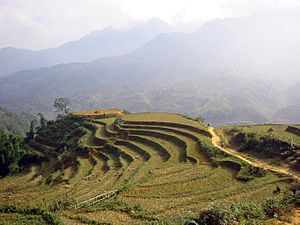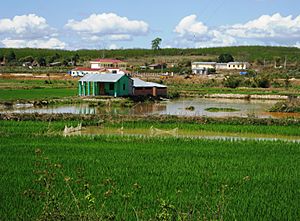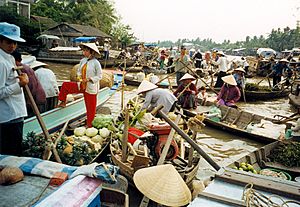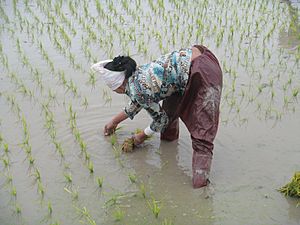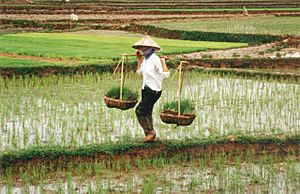Rice production in Vietnam facts for kids
Rice production in Vietnam is super important for feeding the country and helping its economy. Vietnam is one of the world's best farming areas. It's the second-largest rice exporter globally, right after Thailand. People in Vietnam eat a lot of rice too, making them the seventh-largest consumers worldwide.
The Mekong Delta is the main area where rice grows in Vietnam. It's a place where rivers, boats, homes, and markets all work together to produce huge amounts of rice. Rice is a key food for Vietnamese people. Many see it as a "gift from God."
The Mekong River and its smaller rivers are vital for growing rice in Vietnam. About 12 provinces make up the Mekong Delta, often called the "Rice Bowl" of Vietnam. Around 17 million people live there, and 80% of them grow rice. In 2008, this delta produced about 20 million tons of rice. That's half of Vietnam's total rice! Rice provides 75% of the daily calories for people in the delta. It's also a main food for almost half of the world's 7.4 billion people.
Besides rice, farmers in the delta also raise fish and shrimp in their rice fields. They also raise animals, grow other crops, and plant fruit trees. Mangrove forests are also grown in some parts of the delta to help the environment.
Contents
Where Rice Grows in Vietnam
Vietnam has a total land area of 33 million hectares. Rice grows differently in three main areas:
- The southern delta: This area grows the most rice. It's warm and sunny all year.
- The northern delta: This area has a tropical monsoon climate with cold winters. Rice here depends on rain and can be affected by floods.
- The northern highlands: This area grows upland rice varieties.
The southern delta grows about 60% of Vietnam's rice, the northern delta 32%, and the highlands 8%.
The Mekong Delta is Vietnam's "rice bowl." It's located south of Ho Chi Minh City. The Mekong River brings a lot of rich, helpful silt (fine soil) to this area. This silt builds up so much that the coastline grows by about 80 meters (260 feet) each year! Deltas form when a river meets the sea or a lake. They are shaped like a triangle and have very fertile soil, perfect for growing rice. Farmers and fishermen live here, working in farming and raising fish.
The Mekong River starts in the Tibetan mountains. It flows for about 4,350 kilometers (2,700 miles) through six countries in Southeast Asia. It goes through Myanmar, then forms the border between Laos and Thailand. After that, it flows through Cambodia (past Phnom Penh) and enters Vietnam. In Vietnam, it forms the third-largest delta in the world – the Mekong Delta – before flowing into the South China Sea.
In Cambodia, the river splits into two main branches: the Hậu Giang (Lower River) and the Tiền Giang (Upper River). The Tien Giang branch then splits into many smaller rivers. This is why the Mekong River is called "Song Cuu Long" in Vietnamese, which means "River of Nine Dragons." A lake from Cambodia called Tonlé Sap also flows into the Mekong River. This lake helps store floodwaters during the rainy season. The delta itself is very flat, usually only 0 to 3 meters (0 to 10 feet) above sea level. It looks like a huge green carpet!
The river's water level changes a lot. It can be very low in the dry season and very high during floods, especially in September. Floods often cause damage to rice fields and other crops. Because the delta is so flat and low, houses are built on stilts, and roads are raised on banks. Canals are often used for transport and are kept clear for boats. The Mekong Delta is less likely to have big storms compared to other rice-growing deltas.
Besides rice, the delta is also known for fishing. Giant catfish are popular, some growing up to 3 meters (10 feet) long! Irrawaddy dolphins live in the upper parts of the river in Cambodia and Laos. Many types of turtles, water snakes, and insects also live in the delta. The delta also provides animal products like pigs, ducks, chickens, and cattle.
Some interesting places in the Mekong Delta include: Vĩnh Long homes, Mỹ Tho (a town founded by Chinese refugees in 1680, now a fishing and rice farming center), Bến Tre town and its canals, Khmer temples, Trà Vinh (home to the Mekong's first people), floating fish farms, Cham villages near Châu Đốc, and Phú Quốc island.
The Story of Rice
Rice is called 'white gold' in Vietnam. It's linked to the Sanskrit word 'Dhanya,' which means "the sustainer of the human race." In Vietnam, there's a folk story about rice. Long ago, people didn't grow rice. They prayed, and rice would appear from the sky as a big ball in every house. One day, a lady was sweeping her house for the rice ball. The big rice ball landed while she was still sweeping, hit her broom, and broke into many pieces. Since then, people in Vietnam have had to work hard to grow rice with their own hands.
People probably started growing rice between 8,000 and 15,000 years ago. Since then, rice has been grown successfully in Vietnam, China, India, and many other places. Traders and sailors helped spread rice around the world, making it the important food it is today.
A Look at History
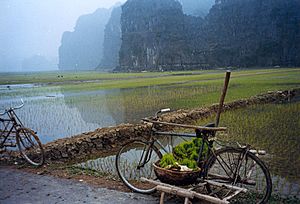
Rice farming in the Mekong Delta has a long history. It was part of the Khmer kingdom in the 18th century before the Vietnamese took control. However, Cambodians still call this area "KamPuchea Krom" (Lower Cambodia), remembering when it was theirs. Cambodia even attacked Vietnam in 1978 to try and take back the Mekong Delta, but they lost. This delta was the last part of modern Vietnam to be taken from Cambodia.
Today, the delta is a huge green area of rice fields. This growth is partly thanks to the French, who took over Vietnam in the mid-1800s. Their main goal was to export rice from the delta to pay for their rule. They built many canals in the delta to allow three rice harvests a year.
During World War II, Japan occupied Vietnam. They took a lot of rice from the delta to feed their own country, which meant millions of Vietnamese people didn't have enough food. The Allies, especially the United States, bombed roads, making it hard to move rice from the south to the north. Both France and Japan forced farmers to give up food for their soldiers. This led to a terrible famine in Vietnam, starting in 1943 and getting very bad in 1945. About two million Vietnamese people died from starvation. This was blamed on Japanese rule and made worse by big floods. In March 1945, Japan removed the French government and set up a Vietnamese government led by Trần Trọng Kim. This new government tried to help, but Japan still kept rice for its military.
Rice production slowed down in both North and South Vietnam in the 1960s because of the Vietnam War. The war caused many problems for farming. South Vietnam even had to import rice by 1965, but production did increase in the 1970s.
After the Vietnam War ended in 1975, the country faced big challenges. The new Communist government set up cooperative farms. They gave farmers seeds, fertilizer, and other important supplies. This system was called "the iron rice bowl." It meant that while no one would get rich, the government promised to take care of everyone. All rice fields became government property. People wanting to buy rice from the delta were even limited to 80 kilograms (176 pounds) and checked by police. Floods and insect problems made things even harder.
In 1986, the government realized this system wasn't working. They allowed farmers to "grow and sell their own rice." This gave farmers a reason to grow more rice, and Vietnam quickly became a top rice exporter. New laws were made, like the Land Law of 1994, which gave farmers rights to their land. This helped the Mekong Delta grow fast and increased people's incomes. The delta is now very populated. Most people are ethnic Vietnamese, with smaller groups of Chinese, Khmers, and Chams. The government gave farmers 50-year leases to own their land and allowed them to rent it out. This created a "land market" and helped transfer land from cooperatives to families.
In 2008, Vietnam aimed to produce a record 36.5 million tons of rice. However, in 2010, a heat wave with temperatures above 35°C (95°F) for three months threatened the rice industry.
The Mekong Delta is also a wetland, and it has received a lot of money from the government and private companies. This money helps maintain the canal system and expand farming to include raising fish along with rice. The delta also grows sugar cane, fruit, and coconuts.
How Much Rice is Produced?
Rice production in the Mekong Delta has grown a lot recently, even with some droughts. This increase is due to new, fast-growing rice types, better farming methods, and helpful government laws. The International Rice Research Institute (IRRI) developed 42 new rice types that are now used in 60% of the irrigated rice fields in the delta.
The area used for rice farming grew from 4.744 million hectares in 1961 to 7.305 million hectares in 2007. Rice production in Vietnam also jumped from 8.997 million tons in 1961 to 35.567 million tons in 2007. That's almost four times more rice in 46 years!
Working Together for Rice
The International Rice Research Institute (IRRI) in the Philippines has greatly helped Vietnam learn more about rice farming. Their research aims to grow rice faster and get bigger harvests. This has given Vietnamese scientists confidence that their country could one day feed the world with rice. IRRI has trained Vietnamese scientists since 1970. These trained scientists now work in important rice research centers, universities, and government groups in Vietnam.
In 1994, the President of the Socialist Republic of Vietnam gave IRRI a Friendship Order. This award recognized IRRI's "very efficient contribution" to rice development in Vietnam.
Besides bringing new rice types, IRRI has also helped Vietnam improve rice production and farmer income. They've done this by:
- Helping farmers share information about pest control, like the "no early insecticide spray" rule.
- Teaching better ways to manage nutrients in the soil.
- Improving water management with help from the Australian Government.
- Supporting the Cuu Long Delta Rice Research Institute with help from the UNDP.
- Working with Vietnamese groups on research projects about hybrid rice, insect problems, and soil issues.
Studies show that turning coastal wetlands into rice fields in tidal areas needs careful planning. Farmers must check the soil for salt and acid levels first.
Types of Rice in Vietnam
Modern farming methods and new types of rice are becoming popular. More than 1,600 different kinds of rice are grown in the Mekong Delta.
Even as farming becomes more modern, traditional wooden farm tools and older rice types are still kept. One special type is "floating" rice. Its stems can grow several feet long, keeping the plant above rising floodwaters. Old rice types are important because they are strong and can grow in difficult soils, like acid or salty areas. They also taste good and have unique flavors that can be used to create new rice varieties.
Rice in Vietnamese Meals
Rice is the main food in Vietnam. People often say their three meals a day are "rice and something else." If rice isn't eaten, it's just a snack, not a meal! Vietnamese food has been influenced by many cultures over centuries. The Chinese ruled for over 1,000 years, and the national dish, phở (rice noodle soup), was created around the 10th century. Later, Cambodian influence brought Indian dishes and taught them how to mix spices. The French also brought their cooking styles, like salads.
At a Vietnamese dining table, rice is always the main dish in the center, with other foods around it. Breakfast often starts with noodle soup, a rice porridge called pho, or a "rice cake wrapped in a banana leaf." Lunch usually has rice vermicelli with grilled meat or seafood. Dinner is often similar to lunch, with rice as the main part.
There are many kinds of rice in Vietnam. The most common are:
- White rice: Eaten at almost every meal.
- Jasmine rice: A moist rice often used by wealthier people.
- Sweet or sticky rice (xôi or glutinous rice): Steamed rice that is sweetened and mixed with other things. It's eaten for breakfast or as a dessert.
- Broken rice (Com Tam): Steamed and common in restaurants. Each type has its own special qualities.
2010 Drought Impact
In 2010, the rice industry faced a big threat from a heat wave. Temperatures were above 35°C (95°F) for at least three months. This weather was caused by the El Niño effect. The Yunnan region in China, where the Mekong River starts, also had a drought. River levels were very low. At least 100,000 hectares (247,000 acres) of land were at risk. If the drought continued, up to 500,000–800,000 hectares (1.2–2 million acres) of rice fields could have been affected.
Vietnam's rice exports dropped in early 2010. In January and February, exports fell by 24.9% to about 781,000 tons. Money earned from exports also dropped by 6.8% to $437 million. Experts predicted that rice exports in the first three months would fall by 33–41%. The situation was serious. The Mekong Region Commission, a group of governments, noted that countries in the region were not as ready for droughts as they were for floods.
|



